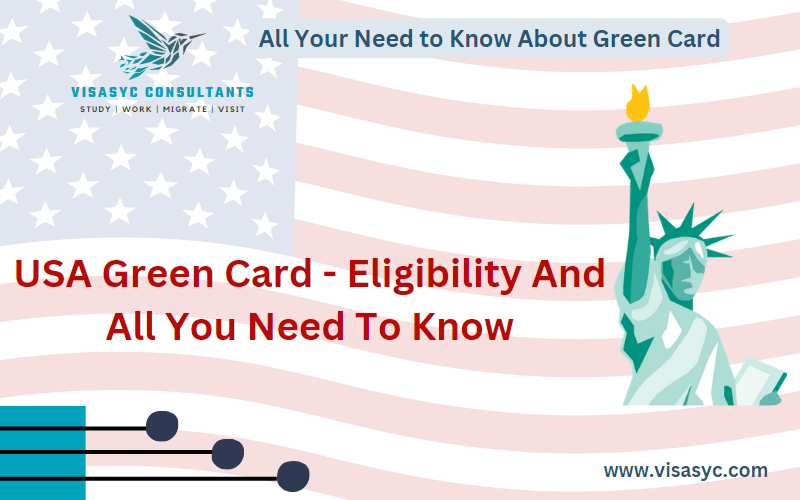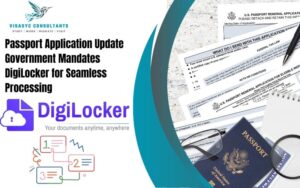America is a place of possibilities. Once a foreign-born citizen obtains permanent residence status, more opportunities become available. America has more immigrants than any other country in the world, with around 44.8 million immigrants living in the country as of 2018. The majority of foreign-born citizens aspire to become permanent residents. This page will provide an overview of the procedure and outline the many options for obtaining permanent residency, also known as a green card.
What is Green Card in USA?
A Permanent Resident Card, sometimes known as a Green Card, allows someone to live and work permanently in the United States. Once you have a green card, you do not need a visa to enter the United States and can work for anyone or start a business. The Green Card is no longer totally green, but rather a blend of green and blue with a US flag in the backdrop. The current sample of a green card is shown below.
How to get Green Card in US – Paths
There are various options for obtaining a Green Card. The majority of Green Card holders are sponsored by a close family member or their job. However, there are various alternative options. Special immigrants, refugees, or asylees, victims of human trafficking or crime, and victims of abuse can all qualify. There are also a few exceptions that pertain to very specific groups of people. The spouse and unmarried children under the age of 21 of the individual being sponsored for a Green Card (commonly referred to as the “beneficiary”) can normally apply for one, as can a derivative applicant.
Individuals apply under these categories, which are labelled with Green Card Category Codes such as E11, CR2, IR1, and so on. In order to track wait times, the US Department of State provides priority dates based on these category codes. This category code is also printed on the physical Green Card that is issued to an individual.
It is also crucial to know that various categories of green cards have certain quotas and limits. Sometimes you have to wait a long time before getting a green card. It is usually determined by your country of origin and the type of green card you are applying for.
Let’s take a closer look at the two key avenues to obtaining a green card, family and employment.
Green Card through Family
The majority of Green Card recipients have their Green Cards sponsored by a family member. There are numerous types based on family:
Immediate relatives of U.S. citizens:A spouse, unmarried kid under the age of 21, or the parent of a U.S. citizen is considered an immediate relative. The main condition is that US citizens be at least 21 years old in order to sponsor a parent. Because there is no restriction or limit on the number of visas that can be given in this category, beneficiaries can acquire Green Cards immediately once their petition is approved without having to wait for a visa number to become available. However, derivative beneficiaries may not apply in this group.
Other family members of U.S. citizens:This category includes children of US citizens who are married and/or over the age of 21. This group also includes siblings of US citizens. Grandparents, aunts, uncles, and cousins are not considered close relations. Because there are more candidates in this category than there are available green cards in this category each year, everyone applying must wait. Once their green card petition has been granted by USCIS, they must usually wait for a green card slot number to become available. Citizens of China, India, Mexico, and the Philippines face the greatest wait times for a green card, with some waiting for more than 20 years.
Fiancé(e)s of U.S. citizens:Citizens of the United States may appeal for a visa to allow a foreign fiancé(e) to visit the United States. The foreign national and US citizen must marry within 90 days of their presence in the United States. After being married, a US citizen can sponsor their spouse for a Green Card.
Widow(er)s of American citizens: If a U.S. citizen files a Green Card application for their spouse but dies before the application is accepted, the (widow)er is still eligible for a Green Card. Widow(er)s who did not have a pending application when their spouse died had two years to file a Green Card application.
VAWA self-petitioners : The Violence Against Women Act (VAWA) allows victims of domestic violence perpetrated by a U.S. citizen spouse, ex spouse, parent, or child to apply for a Green Card. This group includes persons who have been abused by a Green Card-holding spouse, previous spouse, or parent. Self-petitioners under VAWA may apply without their abuser’s knowledge or approval.
Green Card through Employment
Another typical route to receive a Green Card in the United States is through an employer’s sponsorship. Spouses and unmarried minor children of the sponsored employee are also eligible to apply for a green card. There is a limit on the number of visas awarded in a given year, similar to some family-based categories, which generates a backlog. Citizens from China, El Salvador, Guatemala, Honduras, India, Mexico, the Philippines, and Vietnam usually have to wait the longest.
For those pursuing a Green Card through job, there are five basic categories. A visa number can take more than ten years to become accessible, depending on the preferred category. The five categories of employment-based green cards are listed below.
Employment Based First Preference (EB-1): This category is open to anyone with exceptional competence in their profession, as well as great professors/researchers and certain international executives/managers.
Employment Based Second Preference (EB-2): Anyone with exceptional (a step down from extraordinary (EB1), but still a high bar) ability in their field, advanced degrees, or whose employment is considered to be in the national interest of the United States (such as doctors working in underserved areas) can apply for the EB2 category. You may also be eligible if you have substantial expertise in your field.
Employment Based Third Preference (EB-3): The EB3 category includes the majority of other professionals, both skilled and unskilled.
Employment Based Fourth Preference (EB-4): This category is made up of several sub-categories that do not fall under EB1, EB2, or EB3. It includes religious workers, special immigrant juveniles (SIJ), broadcasters, NATO employees, members of the armed forces, Panama Canal Zone employees, certain doctors, and Afghani and Iraqi citizens who have served as translators or otherwise assisted US operations in those countries.
Employment-Based Fifth Preference (EB-5): The EB5 category permits qualified investors to apply for a Green Card. These requirements include investing at least $900,000 in a rural or high-unemployment area, or at least $1,800,000 in other geographic areas, to create at least 10 jobs in a new business or save jobs in an existing struggling business.
Other Categories of Green Cards
In addition to the two major categories mentioned above, there are various more ways to obtain a Green Card in the United States. The various options for obtaining a green card are listed below.
Asylees and Refugees: Those granted asylum are eligible to apply for a Green Card. One year after being awarded asylum, they can normally apply for a green card through the adjustment of status process. One year after being admitted to the United States, refugees can apply for a green card.
Victims of Human Trafficking and Crime: Those who have previously received a temporary visa as a victim of Human Trafficking (T visa) or Crime (U visa) can apply for a Green Card through adjustment of status if specific conditions are met.
Victims of Abuse: In addition to the family-based VAWA category, some children who have been identified as victims of abuse, neglect, or abandonment are eligible to petition for a Green Card and alter their status as Special Immigrant Juveniles.
Diversity Immigrant Visa Lottery: Perhaps the most well-known of these categories is the Diversity Immigrant Visa Programme. Each year, 50,000 visas are reserved for people from low-immigration nations, and winners are chosen by a lottery. The majority of persons chosen live outside the United States and obtain their Green Card through consular processing. A tiny number are already in the United States on temporary visas. Instead, these lottery winners may choose to change their status.
Other Categories: There are a few other ways to obtain a Green Card, the majority of which pertain to people from specific nations who match very precise criteria, such as select Cuban nationals, the Liberian Refugee programme, American Indians born in Canada, diplomats, and so on.
Green Card through Registry: Those who have lived continuously in the United States since January 1, 1972, are eligible for Green Cards through the Adjustment of Status process. Unlike other groups, such applicants are exempt from having a medical exam.
Some people find it easier to obtain a Green Card than others, but anyone going through this process should be informed that it normally takes a significant investment of time, effort, and money.
Numerical Limits, Country Caps
The US Congress has placed numerical limits on the number of green cards that can be awarded every year dependent on the category of filing, as mentioned below.
- Green Cards for Families: 226,000 per year
- Green cards based on employment: 140,000 every year
- Green card applications as an immediate family member (spouse, parents, unmarried children under 21) of a US citizen: There are no restrictions.
In addition to the above numerical restrictions, there is a 7% limit established each country, which is commonly referred to as per-country caps. According to this, no country can receive more than 7% of the eligible petitions in the family or employment-based categories. Complete information can be found at Green Card Numerical Limits, Per Country Caps.
Priority Dates, Visa Bulletin
The US Department of State created the notion of priority date to track an applicant’s position in the Green Card issuance queue. In a nutshell, “priority date is your place in queue for obtaining a green card.”
- It is when the I-130 form was properly filed with USCIS for family-based green cards.
- It is when the US Department of Labour accepts the Labour Certification for processing for employment-based green cards.
- It is the date on which USCIS accepts I-140 for processing for employment-based green cards that do not require Labour certification.
The US Department of State tracks priority date movements in the Monthly Visa Bulletin, which lists current priority dates by category and country of birth.
Summary of Green Card Paths in US
Green Card Category |
Various Paths to Green Card under a Category |
||||
| Family | Immediate Relatives of U.S. Citizens | Other Family Members of U.S. Citizens | Fiancé(e) of U.S. Citizens | Widow(ers) of U.S. Citizens | VAWA Self-Petitioners |
| Employment | EB-1: Individuals w/ Extraordinary Ability, Outstanding Professors/ Researchers & Certain Multinational Executives/ Managers | EB-2: Individuals w/ Exceptional Ability, Advanced Degrees or whose employment is in the national interest | EB-3: Most Other Professional, Skilled or Unskilled Workers | EB-4: Various subcategories | EB-5: Immigrant Investors |
| Asylees & Refugees | Asylees: 1 yr. after receiving asylum | Refugees: 1 yr. after admission to U.S. | |||
| Human Trafficking and Crime Victims | Human Trafficking Victims who previously received a T visa | Crime Victims who previously received a U visa | |||
| Victims of Abuse | VAWA Self-Petitioners | Special Immigrant Juveniles | |||
| Other Categories | Diversity Immigrant Visa Program | Various other subcategories that apply to very specific groups of people who meet very specific conditions | |||
| Registry | Individuals who have lived continuously in the U.S. since 01/01/1972 | ||||




